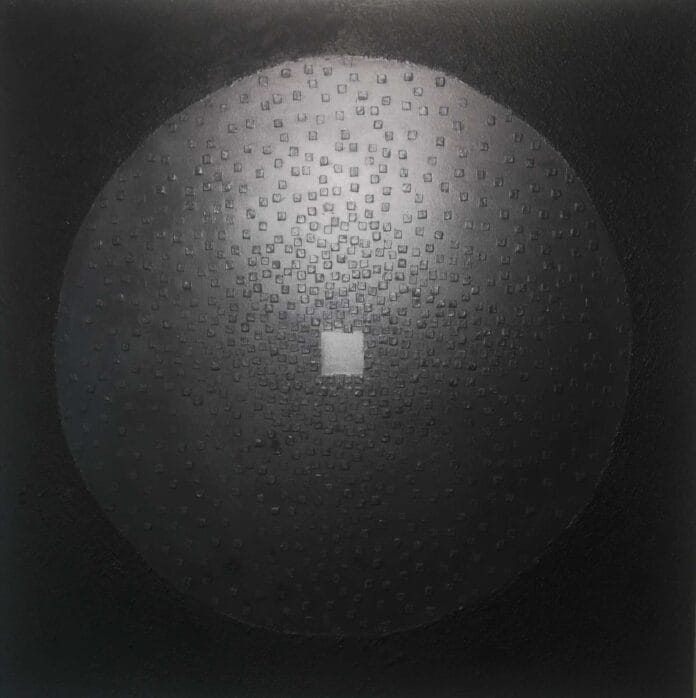Cvetka Hojnik is a Slovenian contemporary artist whose work bridges philosophy, symbolism, and material experimentation. Born in Murska Sobota, Slovenia, Hojnik has developed a unique visual language that reflects on the essential dualities of existence and the interconnectedness of human beings. Through her carefully constructed assemblages, textures, and primal forms, she inspires viewers to consider life’s deeper patterns and universal bonds. Her art is both reflective and transformative, offering a space for awareness, unity, and contemplation.
Artistic Background and Education
Hojnik’s journey into the arts began with a strong foundation in design. She studied Textile and Clothing Design at the University of Ljubljana, where she developed a keen understanding of form, structure, and materiality. Building on this, she pursued a Master of Fine Arts, presenting a thesis titled En Soph – Assemblages and Texturing through Fractal Kabbalah. This academic exploration laid the groundwork for her practice, where philosophy and mysticism blend seamlessly with visual form.
Her academic background continues to shape her art, which often carries a conceptual rigor while embracing experimentation with materials and textures. By merging design principles with symbolic inquiry, Hojnik has carved out a distinctive position in contemporary Slovenian and European art.
International Recognition and Exhibitions
Cvetka Hojnik has exhibited widely, both in Slovenia and abroad, earning recognition for her ability to connect abstract forms with universal human themes. In 2013, she presented a major retrospective at the Gallery-Museum Lendava, a milestone in her career that was accompanied by a comprehensive monograph.
She collaborates with eine art galerie in Germany and works closely with curator Peter Hoffman, expanding her presence in the European art scene. Her membership in various Slovenian, Austrian, and international artists’ associations further reflects her commitment to participating in a wider cultural dialogue.
Through her exhibitions, Hojnik introduces audiences across borders to a body of work that is deeply rooted in symbolic exploration yet resonates universally with viewers searching for meaning in a rapidly shifting world.
The Language of Symbols and Forms
At the heart of Hojnik’s artistic philosophy lies her exploration of polarity and interconnectedness. Her works are constructed around contrasts of black and white, presence and absence, simplicity and complexity. These dualities form the foundation of her practice, reflecting the tension and harmony inherent in life itself.
She works with primal geometric forms such as circles, squares, and ellipses, stripping away visual excess to focus on essentials. These shapes carry archetypal resonance, connecting viewers with universal patterns that transcend culture and time. By reducing her visual language to such fundamental symbols, she invites reflection on life’s origins, structures, and eternal cycles.
Materiality and Texture
One of the defining features of Hojnik’s work is her innovative use of texture. She enriches surfaces with discarded materials, transforming what is overlooked or abandoned into something layered with meaning. Through this practice, she not only creates visually striking works but also comments on renewal, transformation, and the hidden potential in the forgotten.
Her palette is equally deliberate. She often works within a triad of black, red, and white. Black and white serve as opposites, anchoring her explorations of polarity, while red emerges as an accent, a pulse of life, passion, and transformation. These choices imbue her works with both restraint and vitality, balancing minimalism with emotional depth.
Philosophical and Spiritual Dimensions
Hojnik’s MFA thesis, centered on Fractal Kabbalah, reveals her deep interest in philosophy, mysticism, and the structures of thought that govern existence. This influence continues to permeate her art. By weaving symbolic forms and mystical concepts into visual language, she expands the viewer’s encounter beyond the material into the metaphysical.
Her art encourages reflection on human unity, reminding us of the bonds that link individuals across differences. In a fragmented world, her works stand as meditative spaces where polarity does not divide but instead reveals the deeper harmony beneath. She transforms opposites into complements, offering art as a tool for awareness and collective connection.
A Retrospective and Ongoing Journey
The retrospective at the Gallery-Museum Lendava in 2013 was a significant moment in Cvetka Hojnik’s career. Not only did it honor her artistic achievements up to that point, but it also contextualized her work within broader artistic and philosophical discourses. The accompanying monograph allowed for deeper engagement with her practice, providing insights into her processes, influences, and conceptual underpinnings.
Yet Hojnik’s journey is far from complete. Continuously experimenting, she seeks out new ideas, materials, and expressions that challenge and expand her visual language. Her art remains a living dialogue between tradition and innovation, philosophy and materiality, form and meaning.
Living and Working in Lendava
Though her exhibitions span countries and continents, Hojnik remains grounded in her home of Lendava, Slovenia. Living and working there, she draws on both local influences and international connections, weaving them into an artistic identity that is both rooted and expansive. Lendava serves as both a studio space and a contemplative environment, allowing her to engage deeply with her art while remaining connected to her cultural origins.
Conclusion
Cvetka Hojnik’s art is a powerful exploration of life’s essential polarities and the interconnectedness of all beings. Through contrasts of color, primal forms, and textured surfaces enriched with discarded materials, she crafts works that resonate on both visual and philosophical levels. Her practice, informed by design, mysticism, and a dedication to experimentation, invites viewers into a space of reflection and awareness.
By transforming simplicity into depth and polarity into unity, Hojnik reminds us that art can illuminate the invisible threads that bind us together. Her work is not only a testament to her creative vision but also an invitation for each of us to reflect on our place within the vast web of life.


